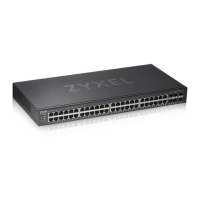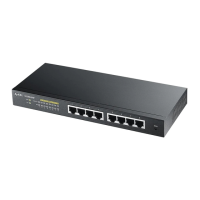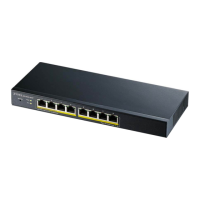GS1920 Series User’s Guide
261
CHAPTER 30
Error Disable
30.1 Error Disable Overview
This chapter shows you how to configure the rate limit for control packets on a port, and set the
Switch to take an action (such as to shut down a port or stop sending packets) on a port when the
Switch detects a pre-configured error. It also shows you how to configure the Switch to
automatically undo the action after the error is gone.
30.1.1 CPU Protection Overview
Switches exchange protocol control packets in a network to get the latest networking information.
If a switch receives large numbers of control packets, such as ARP, BPDU or IGMP packets, which
are to be processed by the CPU, the CPU may become overloaded and be unable to handle regular
tasks properly.
The CPU protection feature allows you to limit the rate of ARP, BPDU and IGMP packets to be
delivered to the CPU on a port. This enhances the CPU efficiency and protects against potential DoS
attacks or errors from other network(s). You then can choose to drop control packets that exceed
the specified rate limit or disable a port on which the packets are received.
30.1.2 Error-Disable Recovery Overview
Some features, such as loop guard or CPU protection, allow the Switch to shut down a port or
discard specific packets on a port when an error is detected on the port. For example, if the Switch
detects that packets sent out the port(s) loop back to the Switch, the Switch can shut down the
port(s) automatically. After that, you need to enable the port(s) or allow the packets on a port
manually via the web configurator or the commands. With error-disable recovery, you can set the
disabled port(s) to become active or start receiving the packets again after the time interval you
specify.
30.1.3 What You Can Do
•Use the Errdisable Status screen (Section 30.3 on page 262) to view whether the Switch
detected that control packets exceeded the rate limit configured for a port or a port is disabled
according to the feature requirements and what action you configure, and related information.
•Use the CPU Protection screen (Section 30.4 on page 264) to limit the maximum number of
control packets (ARP, BPDU and/or IGMP) that the Switch can receive or transmit on a port.
•Use the Errdisable Detect screen (Section 30.5 on page 266) to have the Switch detect
whether the control packets exceed the rate limit configured for a port and configure the action
to take once the limit is exceeded.
•Use the Errdisable Recovery screen (Section 30.6 on page 266) to set the Switch to
automatically undo an action after the error is gone.

